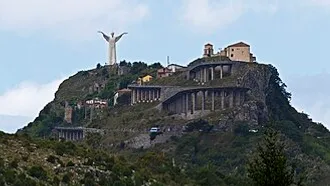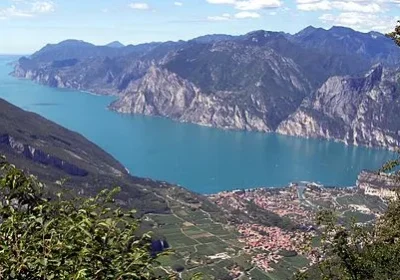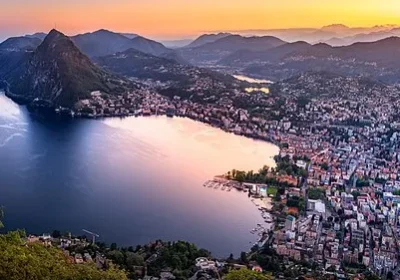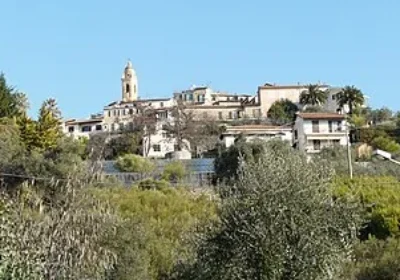Tour 1 SCALEIA-MARATEIA-PRAIA-SAN NICOLA ARCELLA-SCALEIA.
The jewel of northern Calabria.
Just 40 minutes from Scalea, in the town of Maratea, there is an attraction that is a real centre of attraction for tourists from all over the world – the statue of Christ the Redeemer (Cristo Redentore).The sculpture stands on a high hill, between the sky and the sea, as if floating in the air, at a height of 624 metres above sea level. The giant-sized sculpture is made of concrete with white marble sprayed on it. The historic centre of Maratea will fascinate you with its many medieval churches, ancient square, narrow streets, where even in the hottest weather it is always cool and at any time of day smells of coffee and sweet pastries! The place is consecrated by the Pope and nowadays Sunday services are held there.
Further on you go to San Nicola Arcella, a panoramic site with stunning views of the island of Dino and mesmerising seascapes.
TOUR 2 SCALEIA-DIAMANTE-SANTA MARIA del CEDRO-Orzomarso-SCALEIA.
If you ask a traveller what attracts them most to Calabria, they’ll probably say people and towns. It is in these Italian hinterlands that the southern temperament of the Italians, their cheerful disposition and hospitality are fully revealed. Small, cosy, Italian towns are charming, with their unhurried life, where it seems that time itself has slowed down and it is not the booming age of super technology, but the same Italian antiquity of bygone days.
And you can be sure of this when you visit Diamante, a city-museum in the open air. It is famous for its murals. 200 works by artists from all over the world have adorned the walls of homes since 1980. They are all in different artistic styles and themes. The beautiful sea promenade, where the symbol of the city is located – a sculpture in the form of a diamond (in Italian “Dimante” means diamond).
The medieval church, now functioning, with a beautiful organ, numerous cafes and shops, where you will certainly sell hot peppers, limoncello and chedro liqueurs.
Further you will move into the mountains and the marine vegetation gives way to nature, very similar to the middle part of Russia. This is where the Pollino National Park begins. But before that you will visit the Cedro Museum (museo del cedro di Calabria), which is housed in the former prison of Carcere dell Impresa, a 15th-16th century building. There you will learn all about this amazing citron cedro, which grows only in our area, where the temperature and humidity are constant all year round. You will taste liqueurs, syrups, and marmalades made from chedro and, if you wish, you will be able to buy your favourite products.
On your way to Orsomarso you will see how this famous citron grows.
The last point of the journey is the ancient town of Orsomarso, lost in the mountains, where the Basilian monks did their monastic work in ancient times. It was from here that St Luke, St Marko and St Thomas came out. The place itself has a quiet and peaceful atmosphere and is far removed from the hustle and bustle of the world. The historical centre of Orsomarso, the grottoes, the church of St John the Baptist, the fortress wall and the ruins of the baronial castle, all of this will remain in your memory for a long time to come.
TUR 3 SCALEA-AVENA-PAPASIDERO-SCALEA.
The name “Papasidero” and the rock painting with the image of a bull many remember from the school textbook of the history of the ancient world. In general, it is not surprising that this particular drawing made it into an old Soviet textbook – the image of a bull is considered to be the most famous artefact of its kind in Europe. Who would have thought that this very Papasidero would one day be within direct reach – closer than forty kilometres from Scalea!
The road winds serpentinely among the mountains, revealing breathtakingly beautiful scenery. You pass several villages, then the town itself, located in the depths of the Parco Nazionale del Pollino, where you will return on the way back and see many historical monuments of the Middle Ages. The Church of St Constantine (14th century), the Sanctuary of St Mary of Constantinople (17th century), the Norman castle (11th-12th century), the Chapel of St Sophia (11th-12th century).
After Papasidero, about 11-15 km away, there is a very small settlement called Avena, where you will find the Grota dei Romito, a site of primitive people, a cave with burial and rock paintings and a cave with stalactites. You will also visit the archaeological museum, which contains many ancient exhibits.
TUR 4 SCALEIA-THERME LOUIGIANE-SCALE.
The springs have been popular with the Romans since ancient times. But then there were periods when the springs were forgotten, abandoned. It was only in 1850, thanks to Luigi di Bourbon, that the springs were rediscovered and the Terme Luigiane spa was created.
According to legend, French Queen Isabella was cured of infertility by bathing in one of the springs during her visit to Calabria. The hot (47- 84 C0) hydrogen sulphide springs enriched with sodium, chlorine, bromine and iodine, as well as very rare thermo-mineral mud successfully treat diseases of the musculoskeletal apparatus, gynaecological, respiratory and dermatological problems.
The advantages of this thermal resort are also its proximity to the sea, so it is possible to combine a holiday at the sea with a healthy treatment.
The Luigiane thermal baths are classified as 1°Super and use sulphurous water with the highest sulphur content in Italy (173 mg/l)

















